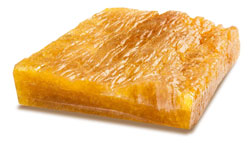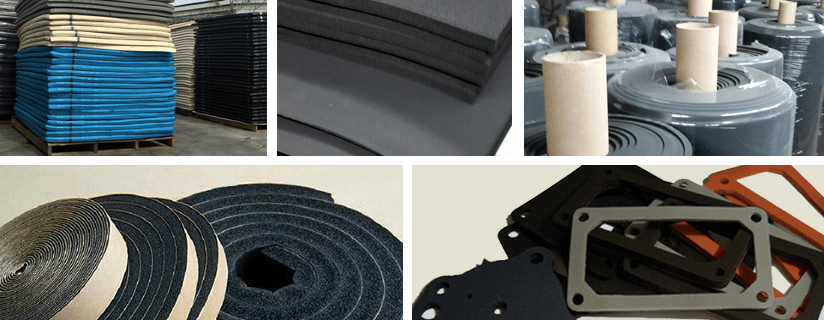Welcome to Rubber and Plastics.
Everything you need to know about sythnthetic rubber & plastic

Rubber Plastic
Plastic and rubber are made from the same families of polymers. A polymer is made up of many many molecules strung together to form long chains. Polymers behave diferently depending on what kinds of molecules they’re made up of and how they’re put together. Within the rubber industry, a polymer is a rubber which is composed of two or more monomers. In other words, SBR, which is a polymer, is made up of the monomers Styrene and Butadiene. They are polymerized (chemically reacted) to form Styrene Butadiene rubber (SBR) which is significantly different than either of the two base monomers from which it was made. In this context, the word polymer is a generic chemical name for all synthetic rubber and plastic materials.
Rubber is a name given to a lot of different polymers that are all elastomers. That is, they recover shape after being stretched or deformed. One well-known natural rubber polymer is polyisoprene, or natural rubber from the sap of hevea trees in Central America. Rubber got its name when people in Britain figured out that it could be used to erase or “rub out” mistakes made with a pencil. The little blobs used to rub out errors were called “rubbers.
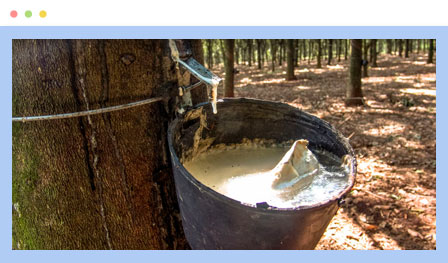
NATURAL RUBBER
Natural rubber is treated to give it crosslinks, which makes it an even better elastomer. When rubber is crosslinked, it won’t melt when it gets hot. That’s why rubber car tires don’t melt even though they get very hot from friction with the road. Polyisoprene can be made synthetically almost as well as it is found in nature. The first synthetic elastomer, or rubber, to be a hit commercially was Polychloroprene. It is commonly known as neoprene rubber.
Rubber and plastic within the same chemical family are chemically compatible and came be blended with each other in all ratios. This is how a synthetic rubber material gets its unique characteristics.
Rubber, or Plastic?
The term rubber has now become generic. It is used to mean anything that is rubber-like. This includes some plastic materials that have rubber-like characteristics. Originally the term was used to define natural rubber. However, now a whole family of synthetic rubbers and plastics are referred to, and correctly so, as rubber or rubber-like; for example, CR (chloroprene rubber, neoprene); SBR (styrene butadiene rubber); NBR (nitrile butadiene rubber); and EPDM (ethylene propylene diene methylene). Certain plastics such as PVC (poly vinyl chloride) and polyethylene can be compounded and cured to have properties that are considered rubber-like. PVC is commonly used in rubber flooring. Vulcanization is an irreversible chemical process which transforms the putty-like, dough-like, or chewing gum-like rubber into a product that has tensile, elongation and memory similar to a rubber band. This amazing transformation from one physical state to another is what makes rubber different from plastic.
 Vulcanization made possible the hollow rubber duck we know and love.
Vulcanization made possible the hollow rubber duck we know and love.
Plastics are usually thought of as thermal plastic materials. In other words, when they get hot they soften, and when they get cold they harden similar to candle wax. Rubber, however, over a much higher and lower temperature range will maintain its original room temperature physical properties such as elongation, memory, tensile and hardness.
Generally speaking – In “Rubber is what rubber does.” Anything that has bounce, stretch, elongation, or memory (meaning that it returns to its original shape when the force of deformation is removed) is referred to as rubber.
Rubber is tough, holds shape once formed, even at high temperatures. It stretches, snaps back, has good tensile strength and is medically safe, soft, pliable, and pure. It is used to make automobile tires, rubber bands and baby bottle nipples.
Plastic has no stretch, it is not pliable, is brittle, and cracks easily. Plastic does not typically have great strength, can’t withstand dishwasher heat . It has a better temperature range, does not stretch and is lightweight, tough, inexpensive, and weather-resistant.
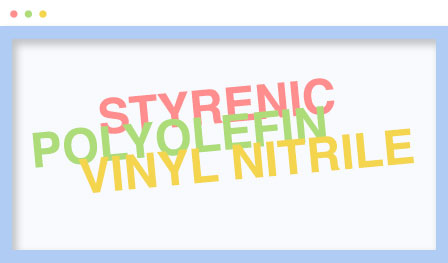
Families of Polymers
Polymers are found in three well-known families. From the STYRENIC FAMILY we get; for example, SBR (Styrene Butadiene Rubber) and the plastic Polystyrene. From the POLYOLEFIN FAMILY we get; for example, EPDM (Ethylene Propylene Diene Monomer) rubber and the plastic Polyethylene. From the VINYL NITRILE FAMILY we get NBR (Nitrile Butadiene Rubber) and the plastic PVC (Poly Vinyl Chloride). For a comprehensive description of the differing properties of these materials go here: Closed Cell Gaskets.
Where do Polymers Come From?
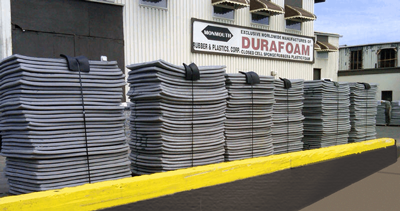 Synthetic rubbers are complex chemical compounds built by means of polymerization of monomers. Rubber manufacturing starts with the refining process of oil, coal or other hydrocarbons with naphtha as one of the resulting products. Naphtha is a hydrocarbon liquid. Each refinery produces its own naphthas with its own physical and compositional characteristics. Naphthas may also be produced from other material such as coal tar, shale deposits, tar sands and the distillation of wood. Naphtha is combined with natural gas to produce monomers. As feed material, typically monomers such as butadiene, styrene, isoprene, chloroprene, acrylonitrile, ethylene or propylene are used.
Synthetic rubbers are complex chemical compounds built by means of polymerization of monomers. Rubber manufacturing starts with the refining process of oil, coal or other hydrocarbons with naphtha as one of the resulting products. Naphtha is a hydrocarbon liquid. Each refinery produces its own naphthas with its own physical and compositional characteristics. Naphthas may also be produced from other material such as coal tar, shale deposits, tar sands and the distillation of wood. Naphtha is combined with natural gas to produce monomers. As feed material, typically monomers such as butadiene, styrene, isoprene, chloroprene, acrylonitrile, ethylene or propylene are used.
These are then treated by polymerization using catalyst and process steam to form chains of polymers that finally result in rubber substances. These substances are then processed to rubber products by vulcanization at a rubber factory.
Crosslinked, Vulcanized, or Cured?
The terms “crosslinked”, “vulcanized” and “cured” mean basically the same thing!
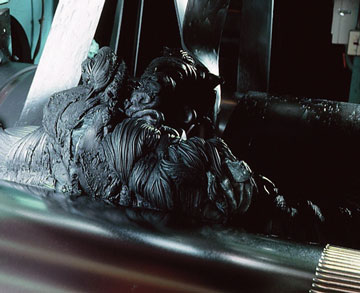 In this process, bales of synthetic rubber, plastic resin, and a variety of different compounding ingredients such as carbon black, clay and process oil are mixed together in an internal mixer. Added to these ingredients are curatives which are chemically very active. Once these chemically active curatives are put into a rubber compound, the process variables that go into making the product must be controlled very closely or else this chemical reaction known as vulcanization will take place too soon and the product will be ruined. Once cured or crosslinked, the rubber or plastic cannot be melted or reverted back to its original form. It retains the shape to which it has been cured or crosslinked. A classical example of this is a car tire. If a car tire were made of non-crosslinked plastic, it would soften and melt once it reached the high temperatures tires are exposed to during their normal wear and tear.
In this process, bales of synthetic rubber, plastic resin, and a variety of different compounding ingredients such as carbon black, clay and process oil are mixed together in an internal mixer. Added to these ingredients are curatives which are chemically very active. Once these chemically active curatives are put into a rubber compound, the process variables that go into making the product must be controlled very closely or else this chemical reaction known as vulcanization will take place too soon and the product will be ruined. Once cured or crosslinked, the rubber or plastic cannot be melted or reverted back to its original form. It retains the shape to which it has been cured or crosslinked. A classical example of this is a car tire. If a car tire were made of non-crosslinked plastic, it would soften and melt once it reached the high temperatures tires are exposed to during their normal wear and tear.
The way an egg reacts with heat is an example of how a product reacts when it is crosslinked. An egg has no shape or form before it is cooked (crosslinked). After it is cooked, it will keep whatever shape in which it has been cooked (vulcanized, cured, crosslinked).
The way a candle and a stick of butter melt and flow with heat are examples of how a plastic product reacts that has not been crosslinked. With relatively low heat they will soften and lose shape quickly. At room temperature they harden again. Because they are not crosslinked, this melting and hardening can be done over and over again to the same candle or piece of butter or plastic.
Blends that have a high rubber content almost always have to be crosslinked. Blends that have a high plastic content are usually not crosslinked.
All rubber products are manufactured in one of two constructions or types. The first type is normally called solid or dense rubber. The second type is normally referred to as cellular or sponge rubber.
Solid (Dense) Rubber
Solid or dense rubber is just what the name implies. It has no cellular structure to it; it is solid. Car tires and rubber bands are two well known examples of solid rubber. A solid rubber formula is basically a recipe just like you would have for a cake. Ingredients are mixed by machines called internal mixers, or mills. Once the formula is thoroughly mixed, small amounts of special ingredients are added. Known collectively as curatives, these generally include accelerators, ultra accelerators, activators, and sulfur. These ingredients are chemically highly active. They are the ingredients in a rubber formula that cause it to vulcanize (cross-link). Vulcanization is a chemical process which transforms the putty-like rubber into a product that has tensile, elongation and memory similar to a rubber band. This is what makes rubber different from plastic.
Solid rubber of all types is very versatile and carries natural resistant properties. Some, like natural gum rubber sheets, are great for use as general sealing materials.
Solid rubber is commonly found in shock absorbing and anti-vibration padding, rubber seals and gaskets in high-stress applications, cushioning and rubber bumper pads where parts impact one another, and protective surfacing used to protect commercial equipment from aesthetic and comprehensive damage.
One of the primary drawbacks of solid rubber for low pressure sealing applications is its high density and, price. However, if you put some air in solid rubber and make it sponge-like, the result is less material per given unit, significantly reducing its cost.
Hence, the popularity of cellular rubber. You can find out more about all kind of rubber and common applications here: UL Gaskets.
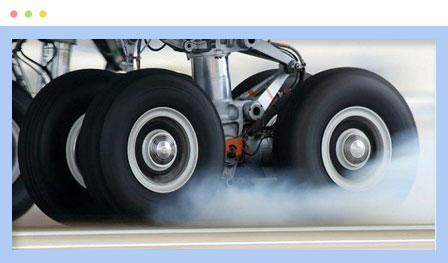
Cellular Rubber
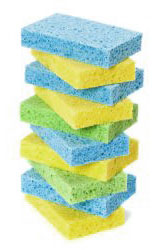 The second category of rubber products is cellular rubber. The first thing we must know in attempting to sell or engineer a rubber product is whether the desired product is solid or cellular rubber. Cellular (sponge rubber), however, is a little more complicated than solid rubber in that it comes in several different forms. They are open-cell sponge rubber and closed-cell expanded rubber. It also comes in a form known as foam.
The second category of rubber products is cellular rubber. The first thing we must know in attempting to sell or engineer a rubber product is whether the desired product is solid or cellular rubber. Cellular (sponge rubber), however, is a little more complicated than solid rubber in that it comes in several different forms. They are open-cell sponge rubber and closed-cell expanded rubber. It also comes in a form known as foam.
Open cell rubber has cells that are open and interconnected to the neighboring cells. This pattern allows air and moisture to seep in easily, giving this rubber an absorbent quality and the ability to regain its physical form after being compressed.
Closed cell or expanded rubber doesn’t allow fluids to seep. This rubber is cheaper and has the ability to float in water which can’t violate its structure. Related topic: Major player of cellular rubber industry.
Closed Cell Rubber
 The technically correct term for closed cell sponge is expanded rubber. Closed cell foam is defined as a cell totally enclosed by its walls and; therefore, not interconnecting with other cells. Closed cell foam comes in a wide variety of material and density options. EPDM, neoprene, EPDM/CR/SBR, and PVC/NBR are a few common types of closed cell foam. Closed foam sheets are usually made by introducing a rubber compound to a gas, such as nitrogen, under high pressure. This type of foam may also be made by incorporating gas-forming materials into the compound. The advantages of high density closed closed cell foam compared to open-cell foam include its strength, higher R-value, and its greater resistance to the leakage of air or water vapor. Closed cell foam is; however, denser, requires more material, and is more expensive.
The technically correct term for closed cell sponge is expanded rubber. Closed cell foam is defined as a cell totally enclosed by its walls and; therefore, not interconnecting with other cells. Closed cell foam comes in a wide variety of material and density options. EPDM, neoprene, EPDM/CR/SBR, and PVC/NBR are a few common types of closed cell foam. Closed foam sheets are usually made by introducing a rubber compound to a gas, such as nitrogen, under high pressure. This type of foam may also be made by incorporating gas-forming materials into the compound. The advantages of high density closed closed cell foam compared to open-cell foam include its strength, higher R-value, and its greater resistance to the leakage of air or water vapor. Closed cell foam is; however, denser, requires more material, and is more expensive.
Closed cell rubber can be ideal for sealing as it effectively reduces liquid and gas flow. It is also ideal in industries in which liquid resistance is critical, such as wetsuits, marine waterproof gaskets, rubber washers, rubber roofing, HVAC, and automotive gaskets where the use of closed cell foam gasket material is very common.
Open Cell Rubber
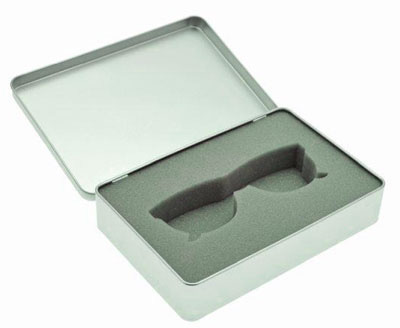 Open-cell sponge rubber is made from many of the same ingredients used in making solid rubber. One ingredient, however, that is added to all cellular rubber formulas and is not in a solid or dense rubber formula is a powder common blowing agent. In the case of open-cell sponge rubber sodium bicarbonate (baking soda) is normally used. When the uncured sponge rubber is heated in a mold, it expands or rises like a cake under low pressure and the baking soda introduces a network of open cells. By open-cell we mean that each cell is connected to the other with an opening so that water, air or gas can pass through them similar to the way water is absorbed by a dish sponge.
Open-cell sponge rubber is made from many of the same ingredients used in making solid rubber. One ingredient, however, that is added to all cellular rubber formulas and is not in a solid or dense rubber formula is a powder common blowing agent. In the case of open-cell sponge rubber sodium bicarbonate (baking soda) is normally used. When the uncured sponge rubber is heated in a mold, it expands or rises like a cake under low pressure and the baking soda introduces a network of open cells. By open-cell we mean that each cell is connected to the other with an opening so that water, air or gas can pass through them similar to the way water is absorbed by a dish sponge.
One outstanding characteristic of open-cell sponge rubber as compared to closed-cell sponge rubber is that open-cell has very good compression set. This is because the air rushes out of the open cells as the material is compressed. As soon as the pressure is released the air rushes back in and the material recovers to basically its full height. This material is recommended when the item will be repeatedly compressed yet must retain its original shape. It can be made into a variety of different rubber gaskets and rubber seals. Typical applications include shock absorption, cushioning, sound and vibration dampening, and gasketing.
Foam Rubber
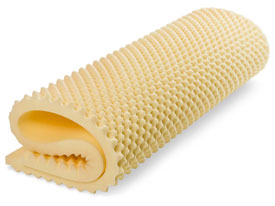 In this context, the term foam denotes a specific manufacturing process where material is foamed into a cellular structure. The most well known foams are polyurethane foam, latex foam, and PVC.
In this context, the term foam denotes a specific manufacturing process where material is foamed into a cellular structure. The most well known foams are polyurethane foam, latex foam, and PVC.
Polyurethane foam is what is commonly used for the cushions on chairs and sofas. All foams are basically open-cell. The term foam denotes inherently a low-pressure process whereby the material is foamed onto a moving belt or into a contained area such as an open-top mold much the same way you would use a can of shaving cream. Once the material has jelled or set, you have a piece of foam. While there are some cells that are closed in any process, the predominant number of cells in a foamed product are open and none of these materials would pass the ASTM water absorption test. This test is a basic requirement of all truly closed-cell materials.
The chief characteristic of polyurethane foam as a gasketing material that makes it so attractive throughout the industry is its low price.
Specifications
The bible specification for flexible closed cell materials is ASTM-D-1056. This specification is titled “SPONGE AND EXPANDED CELLULAR RUBBER PRODUCTS.” Basically all other closed cell specifications are an offshoot in one form or another of ASTM-D-1056.
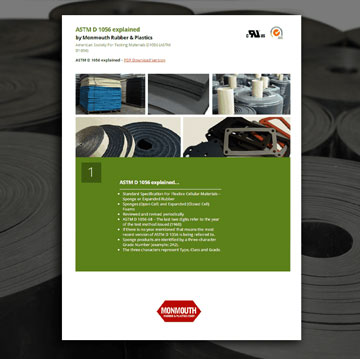 A thorough understanding of ASTM-D-1056 will go a long way toward clearing up a lot of the confusion which exists in the field when attempting to sell and/or specify closed cell products. For example, GM 1379 and SAE J18 are essentially a copy of ASTM-D-1056. Other typical closed cell specs are Mil-R-6130, Mil-C-3133, and Mil Std. 670. These specs are also basically offshoots of ASTM-D-1056. There are basic physical requirements that all closed cell rubbers must have in order to meet ASTM-D-1056. These requirements are as follows:
A thorough understanding of ASTM-D-1056 will go a long way toward clearing up a lot of the confusion which exists in the field when attempting to sell and/or specify closed cell products. For example, GM 1379 and SAE J18 are essentially a copy of ASTM-D-1056. Other typical closed cell specs are Mil-R-6130, Mil-C-3133, and Mil Std. 670. These specs are also basically offshoots of ASTM-D-1056. There are basic physical requirements that all closed cell rubbers must have in order to meet ASTM-D-1056. These requirements are as follows:
1.) A hardness or compression deflection. For example, 2 to 5 PSI.
2.) Oven Aging with a resultant change in original physical limits being ± 30%.
3.) Water absorption maximum by weight 5% for the higher density materials and 10% for the lower density materials.
These three basic requirements are then modified by suffix letters. Some of the suffix letters are specific as to their requirements. Others carry the notation “Values to be arranged between the supplier and the purchaser.” A detailed understanding of what these requirements are can be had by studying ASTM-D-1056.
One overriding factor that causes probably 80% of the confusion on understanding ASTM-D-1056 is the grade numbers and their meaning changes under the different year revisions of the spec. A good resource for deciphering the specifcations can be found here:
http://monmouthrubber.com/astm-d-1056-explained-by-monmouth-rubber-plastics/.

